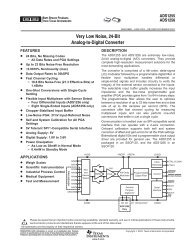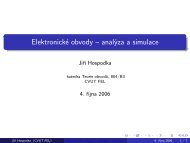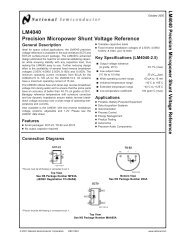<strong>LTC<strong>24</strong>10</strong>APPLICATIO S I FORATIOU W U UV REF +V REF –EXTERNAL OSCILLATOR(153,600HZ)<strong>LTC<strong>24</strong>10</strong>#1<strong>LTC<strong>24</strong>10</strong>#2<strong>LTC<strong>24</strong>10</strong>#3<strong>LTC<strong>24</strong>10</strong>#4V CCF OV CCF OV CCF OV CCF OREF +SCKREF +SCKREF +SCKREF +SCKREF –SDOREF –SDOREF –SDOREF –SDOIN +CSIN +CSIN +CSIN +CSIN –IN –IN –IN –µCONTROLLERGNDGNDGNDGNDSCKSDOCS1CS2CS3CS4CS1CS2CS3CS4SCK31 OR LESSCLOCK PULSESSDO<strong>24</strong>10 F46Figure 46. Using Multiple <strong>LTC<strong>24</strong>10</strong>s to Increase Output Data RateBRIDGE APPLICATIONSTypical strain gauge based bridges deliver only 2mV/Voltof excitation. As the maximum reference voltage of the<strong>LTC<strong>24</strong>10</strong> is 5V, remote sensing of applied excitation<strong>with</strong>out additional circuitry requires that excitation belimited to 5V. This gives only 10mV full scale input signal,which can be resolved to 1 part in 10000 <strong>with</strong>out averaging.For many solid state sensors, this is still better thanthe sensor. Averaging 64 samples however reduces thenoise level by a factor of eight, bringing the resolvingpower to 1 part in 80000, comparable to better weighingsystems. Hysteresis <strong>and</strong> creep effects in the load cells aretypically much greater than this. Most applications thatrequire strain measurements to this level of accuracy aremeasuring slowly changing phenomena, hence the timerequired to average a large number of readings is usuallynot an issue. For those systems that require accuratemeasurement of a small incremental change on a significanttare weight, the lack of history effects in the LTC<strong>24</strong>00family is of great benefit.For those applications that cannot be fulfilled by the<strong>LTC<strong>24</strong>10</strong> alone, compensating for error in external amplificationcan be done effectively due to the “no latency”feature of the <strong>LTC<strong>24</strong>10</strong>. <strong>No</strong> latency operation allowssamples of the amplifier offset <strong>and</strong> gain to be interleaved<strong>with</strong> weighing measurements. The use of correlated doublesampling allows suppression of 1/f noise, offset <strong>and</strong>thermocouple effects <strong>with</strong>in the bridge. Correlated doublesampling involves alternating the polarity of excitation <strong>and</strong>dealing <strong>with</strong> the reversal of input polarity mathematically.Alternatively, bridge excitation can be increased to asmuch as ±10V, if one of several precision attenuation36
<strong>LTC<strong>24</strong>10</strong>APPLICATIO S I FORATIOU W U Utechniques is used to produce a precision divide operationon the reference signal. Another option is the use of areference <strong>with</strong>in the 5V input range of the <strong>LTC<strong>24</strong>10</strong> <strong>and</strong>developing excitation via fixed gain, or LTC1043 basedvoltage multiplication, along <strong>with</strong> remote feedback in theexcitation amplifiers, as shown in Figures 52 <strong>and</strong> 53.Figure 47 shows an example of a simple bridge connection.<strong>No</strong>te that it is suitable for any bridge applicationwhere measurement speed is not of the utmost importance.For many applications where large vessels areweighed, the average weight over an extended period oftime is of concern <strong>and</strong> short term weight is not readilydetermined due to movement of contents, or mechanicalresonance. Often, large weighing applications involve loadcells located at each load bearing point, the output ofwhich can be summed passively prior to the signal processingcircuitry, actively <strong>with</strong> amplification prior to the<strong>ADC</strong>, or can be digitized via multiple <strong>ADC</strong> channels <strong>and</strong>summed mathematically. The mathematical summationof the output of multiple <strong>LTC<strong>24</strong>10</strong>’s provides the benefit ofa root square reduction in noise. The low power consumptionof the <strong>LTC<strong>24</strong>10</strong> makes it attractive for multidropcommunication schemes where the <strong>ADC</strong> is located <strong>with</strong>inthe load-cell housing.A direct connection to a load cell is perhaps best incorporatedinto the load-cell body, as minimizing the distance tothe sensor largely eliminates the need for protection350ΩBRIDGER1R223V REFREF + SDO1<strong>24</strong>REF – SCK1356IN +IN –<strong>LTC<strong>24</strong>10</strong>GNDCSFigure 47. Simple Bridge ConnectionF O11141, 7, 8, 9,10, 15, 16+LT1019<strong>24</strong>10 F47R1 AND R2 CAN BE USED TO INCREASE TOLERABLE AC COMPONENT ON REF SIGNALSdevices, RFI suppression <strong>and</strong> wiring. The <strong>LTC<strong>24</strong>10</strong> exhibitsextremely low temperature dependent drift. As a result,exposure to external ambient temperature ranges doesnot compromise performance. The incorporation of anyamplification considerably complicates thermal stability,as input offset voltages <strong>and</strong> currents, temperature coefficientof gain settling resistors all become factors.The circuit in Figure 48 shows an example of a simpleamplification scheme. This example produces a differentialoutput <strong>with</strong> a common mode voltage of 2.5V, asdetermined by the bridge. The use of a true three amplifierinstrumentation amplifier is not necessary, as the <strong>LTC<strong>24</strong>10</strong>has common mode rejection far beyond that of mostamplifiers. The LTC1051 is a dual autozero amplifier thatcan be used to produce a gain of 15 before its inputreferred noise dominates the <strong>LTC<strong>24</strong>10</strong> noise. This exampleshows a gain of 34, that is determined by a feedbacknetwork built using a resistor array containing 8 individualresistors. The resistors are organized to optimize temperaturetracking in the presence of thermal gradients. Thesecond LTC1051 buffers the low noise input stage fromthe transient load steps produced during conversion.The gain stability <strong>and</strong> accuracy of this approach is verygood, due to a statistical improvement in resistor matching.A gain of 34 may seem low, when compared tocommon practice in earlier generations of load-cell interfaces,however the accuracy of the <strong>LTC<strong>24</strong>10</strong> changes therationale. Achieving high gain accuracy <strong>and</strong> linearity athigher gains may prove difficult, while providing littlebenefit in terms of noise reduction.At a gain of 100, the gain error that could result fromtypical open-loop gain of 160dB is –1ppm, however,worst-case is at the minimum gain of 116dB, giving a gainerror of –158ppm. Worst-case gain error at a gain of 34,is –54ppm. The use of the LTC1051A reduces the worstcasegain error to –33ppm. The advantage of gain higherthan 34, then becomes dubious, as the input referrednoise sees little improvement 1 <strong>and</strong> gain accuracy is potentiallycompromised.<strong>No</strong>te that this 4-amplifier topology has advantages overthe typical integrated 3-amplifier instrumentation amplifierin that it does not have the high noise level common inthe output stage that usually dominates when an instru-37






